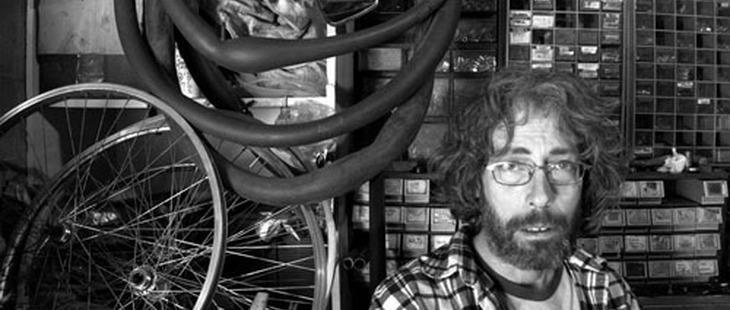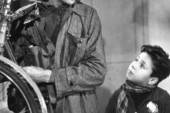
I bang on the door of a garage, hidden off a lane way at Queen and Dunn. A voice screams back “Entrez, entrez!” The door swings open and there is George McKillop, waving a spanner as if it were a trident. To some he might look like a wily hermit, but George is a legend in this city — a renowned bicycle mechanic, purveyor of rare parts, and bearded soothsayer of bike lore. Usually I come and see George if I needed a part or a tune up, but this time I’ve come to talk about him.
“What’s the news?” I ask.
“The news is I’ve changed my trousers since the last time I washed them,” he replies.
As his many friends and admirers will tell you, George has quietly helped build Toronto’s downtown bike community. And he’s now the subject of a documentary, Parts Unknown, named after his former shop in Kensington Market. Screening this summer at the NYC Bike Film Festival, the eight-minute short sheds light on his last days in Kensington before being evicted. The shop, tucked away behind Segovia Meats on Augusta, had been there for 18 years, servicing the many Torontonians whose sole mode of transport were their two wheels. But the slow rising watermark of gentrification in the Market meant it was only a matter of time before the insurance companies and city inspectors descended and shut him down. George was heartbroken at first. His daughter had been conceived in the building; the bike shop had become part of Kensington Market history and folklore. It was a lovely, albeit, unfashionable idea of what a bike shop could be.
“I did lose a few precious items in the move, including my ‘magic wand’ — a screwdriver given to me by my mother. But I scored an awesome girlfriend out of the deal, so I’m not complaining.”
George opens a drawer and takes out a bottle of ros, offering a lunchtime refresher as he sets about rolling a cigarette. For those who knew where to find George in the Market, his recent location is even more discreet. You would never know it was there unless you had his cell phone number and that’s the way he likes it. He professes not to be very good at dealing with the public.
We sit in the garage, surrounded by bike frames, wheels and countless drawers and boxes containing parts. There’s a knock at the door. It’s Ron, a fellow cyclist and regular, dropping by for a chat and a part or two. This represents an average workday for George, regularly halted with bouts of socializing and the odd glass of fortification. Ron is in his early 30s and rides a zippy little no-name hybrid racer, much or nearly all of which has come from George over the years.
“I always come to George if I need a part,” says Ron, “or to tune and tweak my bike. He’s been recycling before the word became popular. And if he didn’t save all these parts, they might not exist at all. He’s also a sweetheart and he’ll never rip you off, and as an initiate bicycle mechanic, I’ve learned an incredible amount from him. He’s a gentleman and a rare breed these days.”
“That’s me, a man of culture,” smiles George.
“Bike George”, as he was called in the Market, has always worked for himself, ever since he started fixing bikes when he was kid growing up in Belleville.
“The reason I started all this, which I now call a performance piece, was that when I was a kid I didn’t want my parents to find out I was wrecking my bike all the time. So I bought a chain tool and got hold of some wrenches and went from there.”
As for bike parts in those early days, he found all he needed in the garbage.
“I had a formula. There were three different bikes available in Belleville: the Canadian Tire Super Cycle Tour de France, The Centurion and then there were the Raleigh Records. So I could build a 23-pound bicycle out of things other people threw away. If I found a Favorit with the derailleur intact that would knock another half a pound off of the bike.”
George digs out the bits Ron is looking for amidst the organized chaos. He’s always had an eye for quality parts, dismissing the cheaply made plastic details, and prefers to concentrate on models ranging from the mid-1950s to the early ’80s. He has a particular focus on the unusual: bikes with five speeds and drum breaks, or three speeds with V-breaks. On the rare occasion he needs parts, be they ball bearings or mudguards, he usually shops at Mountain Equipment Co-op, which he claims is cheaper than his wholesale supplier. Wherever he sources things, he’s built up a huge inventory of well-made parts. At the moment he’s taking apart a Viscount racer rescued from a friend’s garden. Hand-built in England, beautifully brazed with a TA crank, not many people could afford its modern day equivalent. Ron looks interested. Being able to get hold of such items is why George has even developed an international reputation; cyclists from Texas to Tokyo contact him wanting to buy parts. He even has a set of cast-iron wheels for a two-person tricycle from the 1860s.
“That sociable invention came about 20 years after Patrick Macmillan built his first wooden bicycle in 1838,” he says with a swig of wine. “The first bicycle to be built by hand, the first to be involved in a bicycle accident and probably the first bicycle to be stolen as well.”
George’s friends appreciate his sense of humour and eccentricities, respecting a quiet demeanour that borders on shyness. Some of them are that way themselves — unique characters and devoted operators of the pedal power. They also come to George because he is very affordable, to the point that many think he should charge more than $30 for a tune-up. He often resists strangers who bring him bikes and parts, and as a rule will check the serial numbers on frames to see if they are stolen.
Nowadays, George is finding it increasingly hard to keep doing what he loves. He knew his current location would be temporary when he moved in, but the landlord is especially unhappy that George sells parts out the garage. His days here are running out. When a friend named Roy turns up to help George move some of the bikes and gear I can see his mood changing.
“I don’t know if I’ll have another shop after this,” he says while looking over his stock. “Maybe I’ll get organized and sell it all online, before going on a trip somewhere. Do something else, I don’t know.”
It will be a huge loss to many cyclists in Toronto if George does close shop. He may still be available for friends and trusted customers, but Toronto is changing in a way that’s edging out people like him. More than a mere mechanic, George is an artist with a remarkable talent — he simply lacks the means and support to reap the rewards he should command (and a little wriggle room when city rules and codes are concerned). Let’s hope George and Parts Unkown can carry on somehow. Without small, creative operators like George, cycling in Toronto will be awfully dull.














